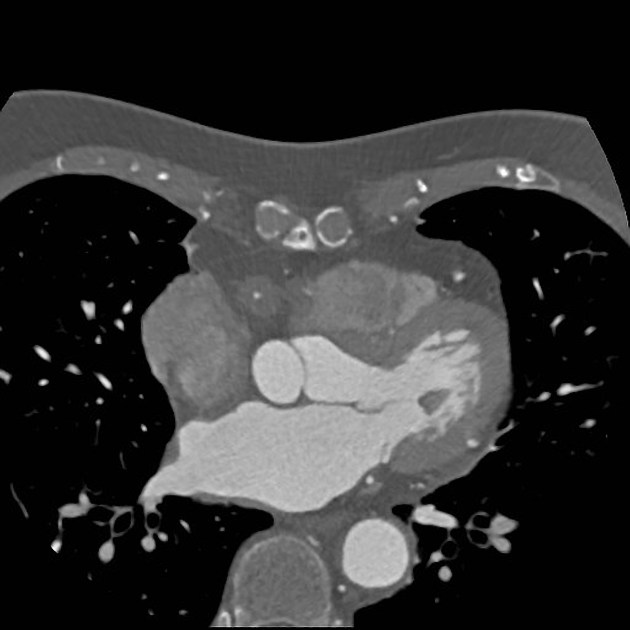Mistletoe sign
Updates to Article Attributes
The mistletoe sign refers to solid enhancing perivascular masses around the coronary arteries in the presence of idiopathic retroperitoneal fibrosis (Ormond's disease).The presence of the mistletoe sign on cardiac MRMRI and coronary CT angiographic images isangiography is relatively rare, but it might be a characteristic manifestation of retroperitoneal fibrosis. With the increasing number of noninvasivenon-invasive cardiac imaging tests performed worldwide, the recognition of this imaging sign could aid the diagnosis of retroperitoneal fibrosis.
History and etymology
A similarThe sign was first described by Pál Maurovich-Horvat and colleagues in 2017 3.
The appearances of the soft tissue around the coronary arteries invokes the appearance can also occur in of mistletoe, a hemiparasitic plant, around the branches of a tree that it has invaded (see Figure 1).
Differential diagnosis
Similar appearances with:
References changed:
- 1. Matsumoto Y, Kasashima S, Kawashima A, et al. A case of multiple immunoglobulin G4-related periarteritis: a tumorous lesion of the coronary artery and abdominal aortic aneurysm. (2008) Human pathology. 39 (6): 975-80. <a href="https://doi.org/10.1016/j.humpath.2007.10.023">doi:10.1016/j.humpath.2007.10.023</a> - <a href="https://www.ncbi.nlm.nih.gov/pubmed/18430457">Pubmed</a> <span class="ref_v4"></span>
- 2. Sakamoto A, Tanaka T, Hirano K, et al. Immunoglobulin G4-related Coronary Periarteritis and Luminal Stenosis in a Patient with a History of Autoimmune Pancreatitis. (2017) Internal medicine (Tokyo, Japan). 56 (18): 2445-2450. <a href="https://doi.org/10.2169/internalmedicine.8259-16">doi:10.2169/internalmedicine.8259-16</a> - <a href="https://www.ncbi.nlm.nih.gov/pubmed/28824056">Pubmed</a> <span class="ref_v4"></span>
- 3. Maurovich-Horvat P, Suhai FI, Czimbalmos C, et al. Coronary Artery Manifestation of Ormond Disease: The "Mistletoe Sign". (2017) Radiology. 282 (2): 356-360. <a href="https://doi.org/10.1148/radiol.2016160644">doi:10.1148/radiol.2016160644</a> - <a href="https://www.ncbi.nlm.nih.gov/pubmed/27548369">Pubmed</a> <span class="ref_v4"></span>
- 4. Xu X, Bai W, Ma H, et al. Remission of "mistletoe sign" after treatment. (2020) Journal of cardiovascular computed tomography. 14 (6): e118-e119. <a href="https://doi.org/10.1016/j.jcct.2019.08.002">doi:10.1016/j.jcct.2019.08.002</a> - <a href="https://www.ncbi.nlm.nih.gov/pubmed/31409552">Pubmed</a> <span class="ref_v4"></span>
- Matsumoto Y, Matsumoto KS, Matsumoto KA, Matsumoto SH, Matsumoto EM, Matsumoto KK, Matsumoto ZY, Matsumoto NY, Matsumoto. A case of multiple immunoglobulin G4-related periarteritis: a tumorous lesion of the coronary artery and abdominal aortic aneurysm. (2008) Human pathology. <a href="https://doi.org/10.1016/j.humpath.2007.10.023">doi:10.1016/j.humpath.2007.10.023</a> - <a href="https://www.ncbi.nlm.nih.gov/pubmed/18430457">Pubmed</a> <span class="ref_v4"></span>
- Sakamoto A, Tanaka T, Hirano K, Koike K, Komuro I. Immunoglobulin G4-related Coronary Periarteritis and Luminal Stenosis in a Patient with a History of Autoimmune Pancreatitis. (2017) Internal medicine (Tokyo, Japan). 56 (18): 2445-2450. <a href="https://doi.org/10.2169/internalmedicine.8259-16">doi:10.2169/internalmedicine.8259-16</a> - <a href="https://www.ncbi.nlm.nih.gov/pubmed/28824056">Pubmed</a> <span class="ref_v4"></span>
- Pál Maurovich-Horvat, Ferenc Imre Suhai, Csilla Czimbalmos, Attila Tóth, David Becker, Emese Kiss, Maros Ferencik, Udo Hoffmann, Hajnalka Vagó, Béla Merkely. Coronary Artery Manifestation of Ormond Disease: The “Mistletoe Sign”. (2016) Radiology. <a href="https://doi.org/10.1148/radiol.2016160644?af=R">doi:10.1148/radiol.2016160644?af=R</a> <span class="ref_v4"></span>
Image 1 Photograph ( create )

Image 2 CT (C+ arterial phase) ( create )







 Unable to process the form. Check for errors and try again.
Unable to process the form. Check for errors and try again.